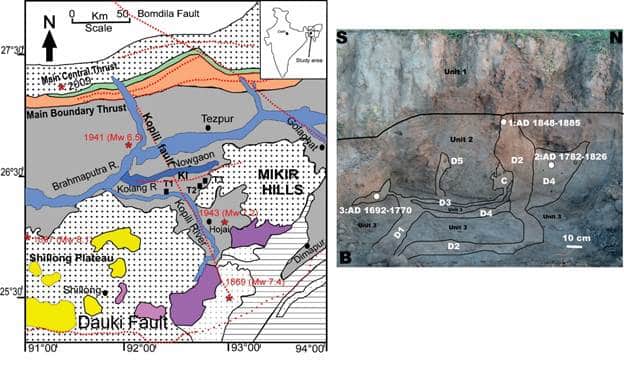About Kopili fault zone
- It is a 300 km long and 50 km wide lineament situated in the northeastern region (NER).
- It extends from the western part of Manipur to the tri-junction of Bhutan, Arunachal Pradesh, and Assam.
- It is closer to Himalayan Frontal Thrust.
- This is a seismically active area falling in the highest Seismic Hazard Zone V.
- It is associated with collisional tectonics because of the Indian Plate subducting beneath the Eurasian Plate.
- The fault itself is a transpressional fracture that generates lower crustal dextral strike-slip earthquakes.
- A tectonic depression filled up by the alluvium of the Kopilli river and its tributaries, the Kopili fault zone has witnessed many seismic activities in the past including the 1869 earthquake (7.8 magnitude) and the 1943 earthquake (7.3 magnitude).
Key points about the research
- Seismogenic liquefaction features, including multiple sand dykes and sand sills, were pinpointed in the Kopili Fault zone.
- To mitigate future earthquake occurrences in the Kopili Fault zone, scientists conducted investigations at three trench sites in the floodplain deposits of the Kolong River, near KF.
- The identified liquefaction features, including sand dykes and sand sills, directly respond to the liquefaction of saturated sediment induced during past seismic activity.
- The study utilized a technique called optically stimulated luminescence (OSL) dating on seven samples from marker horizons to constrain the chronology of liquefaction features.
- The OSL age constraints revealed evidence of two earthquake-induced liquefaction events near the Kopili Fault approximately 480 years ago.
- This crucial information aids in the interpretation of the long-term rupture history of faults and intraplate seismicity in the region.
Q1) What is Dyke?
In geology, a tabular or sheetlike igneous body that is often oriented vertically or steeply inclined to the bedding of preexisting intruded rocks is known as Dyke.
Last updated on June, 2025
→ UPSC Notification 2025 was released on 22nd January 2025.
→ UPSC Prelims Result 2025 is out now for the CSE held on 25 May 2025.
→ UPSC Prelims Question Paper 2025 and Unofficial Prelims Answer Key 2025 are available now.
→ UPSC Calendar 2026 is released on 15th May, 2025.
→ The UPSC Vacancy 2025 were released 1129, out of which 979 were for UPSC CSE and remaining 150 are for UPSC IFoS.
→ UPSC Mains 2025 will be conducted on 22nd August 2025.
→ UPSC Prelims 2026 will be conducted on 24th May, 2026 & UPSC Mains 2026 will be conducted on 21st August 2026.
→ The UPSC Selection Process is of 3 stages-Prelims, Mains and Interview.
→ UPSC Result 2024 is released with latest UPSC Marksheet 2024. Check Now!
→ UPSC Toppers List 2024 is released now. Shakti Dubey is UPSC AIR 1 2024 Topper.
→ Also check Best IAS Coaching in Delhi
























